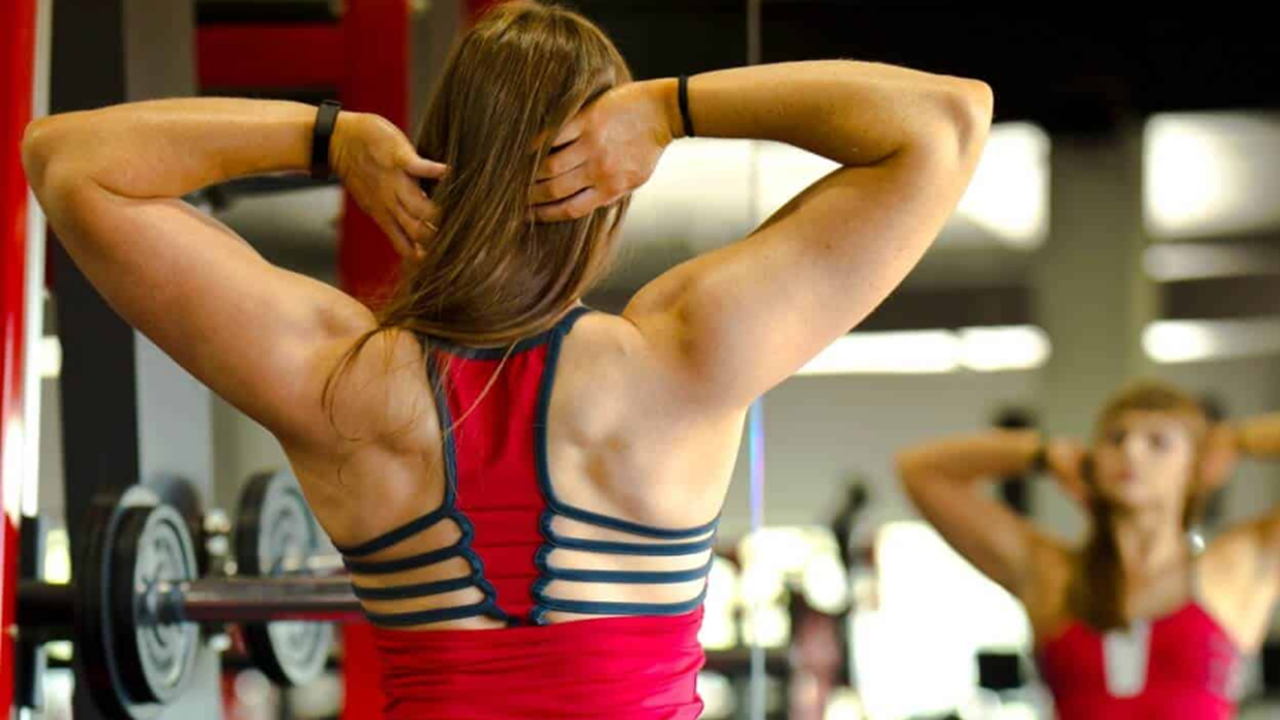
Training opposing muscle groups together works the front and back part of an area on your body at the same time, which promotes strength, stability, and even muscle growth.
As a fitness expert, one of the most common questions people have when they first start strength training is, "What muscle groups do I work out together?"
Whether you're just getting started strength training or you've been in the groove for a while, it's important to be educated on getting the most out of your workouts. I recommend training opposing muscle groups (agonists and antagonists) together because they work together for many of the movements we make, and it's way more efficient.
Simply put, you are working both the front and the back of one particular area of your body within the same session. This training strategy also helps you create a plan to target different areas of your body on different days of the week while still providing necessary rest periods.
So I put together four opposing muscle group workouts with a few of my favorite combinations to exercise together:
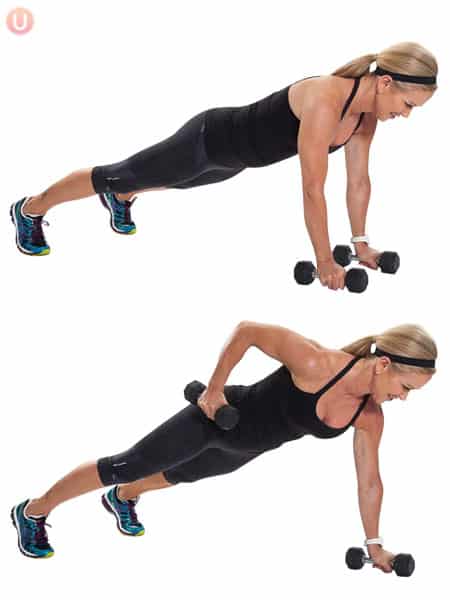
- Workout #1: Chest and Back
- Workout #2: Quads and Hamstrings
- Workout #3: Biceps, Triceps, and Shoulders
- Workout #4: Glutes and Abdominals
These strategic muscle group workouts will help build muscle and promote overall wellbeing!
Muscle Groups Workout #1: Chest & Back
This opposing muscle groups workout will target your chest and back muscles to strengthen and tone your upper body.
Chest & Back Workout Instructions:
- Grab a medium-to-heavy set of dumbbells in a weight that allows you to complete the workout while providing a little challenge (somewhere between 8-15 lbs). I typically use 12 lb dumbbells when working my upper body!
- Complete the exercises below in a circuit format, performing each exercise for a total of 45 seconds, followed by 15 seconds of rest.
- The 15-second rest period allows to you catch your breath and prep for the next movement.
1. Chest Fly
The chest fly is a great strength training exercise that targets your chest and shoulder muscles.
How to Perform a Chest Fly:
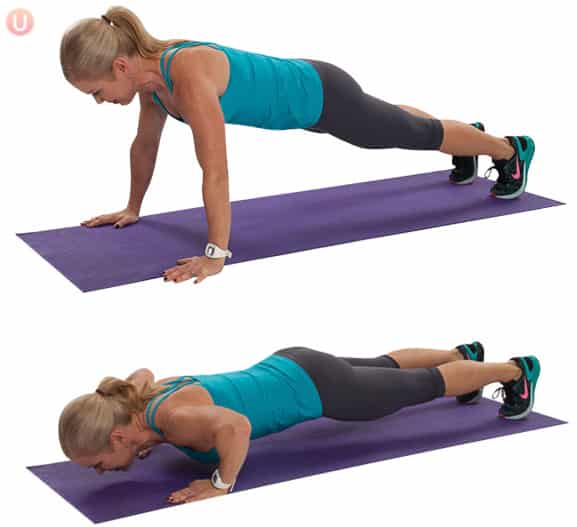
- Lie on your back with knees bent and feet on the floor and hold dumbbells straight up over your chest.
- With a slight bend in the elbow, slowly open arms wide out to the side.
- Squeeze your chest as you bring the weights back together at the top.
- Repeat for the desired number of reps.
2. Renegade Row
The renegade row is a compound exercise that targets your back, shoulder, and core muscles simultaneously. You'll feel your muscles burning, and your heart rate go up!
How to Perform a Renegade Row:
- Begin in a full plank with dumbbells in your hands, arms extended, and toes (kneeling variation is fine if you are not able to do a full plank). Engage your abdominals drawing the belly inward towards your spine.
- Pull the right dumbbell up toward the right hip bone keeping the weight close to your side. Slowly return it to the floor and repeat with the left dumbbell.
3. Push-Up
The push-up is the holy grail of strength moves because it targets several muscle groups in one efficient exercise. Think you need to bench press for great shoulders? Think again!
How to Perform a Push-Up:
- Begin in a plank position with hands below shoulders, legs long behind you, and body contracted to hold your spine in a straight line.
- With elbows pointing slightly back, bend your elbows and slowly begin to lower your body until you are just above the ground. Keep your gaze over your fingertips and body in a straight line.
- As you exhale, tighten your belly and then push yourself back up to a plank position. That is one repetition.
4. Reverse Grip Double Arm Rows
The reverse grip double arm row exercise targets the back muscles, which is an often-overlooked muscle group in women.
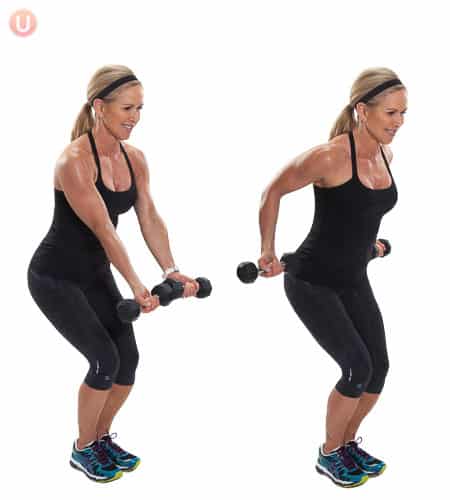
How to Perform a Reverse Grip Double Arm Rows:
- Start with legs together and sit back into a slight squat engaging abdominal. Arms are in front of the body holding dumbbells at hip height with palms facing the ceiling.
- Draw elbows back past hips gently hugging the side body so you feel lats and triceps engage and return forward with control.
5. Chest Press
The chest press is a class move that targets muscle building for your chest, shoulders, and triceps.
How to Perform a Chest Press:
- Lie on the back with knees bent and feet on the floor. Elbows are bent and dumbbells start at shoulder height.
- Extend arms fully pressing away from your chest. Then, slowly lower to the start position.
6. Overhead Pull
The overhead pull exercise effectively targets your shoulders and triceps.
How to Perform an Overhead Pull:
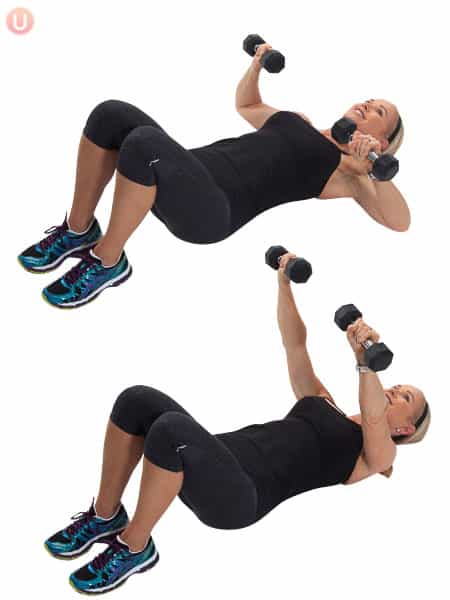
- Lie on back with knees bent and feet on the floor. Arms are extended above the chest to start. Engage your abdominals.
- Lower dumbbells past your head keeping arms mostly straight with elbows slightly bent.
- Keeping abdominals tight, raise dumbbells back to start. The lower back should stay firm against the floor throughout.
Repeat this circuit three times for a complete 20-minute upper-body workout!
Muscle Groups Workout #2: Quads & Hamstring
This opposing muscle group workout focuses on the quads and hamstrings and it will get your legs pumping while improving strength, stability, and performance.
The goal of this lower body workout is to target the quad and hamstring muscles together and to find fatigue in the lower half of your body.
If you get to the last couple of reps and you feel like you can't do one more, that's exactly where you should be. However, if you come to the last couple of reps and feel like you could do more, pick up heavier weights!
Quads and Hamstrings Workout Instructions:
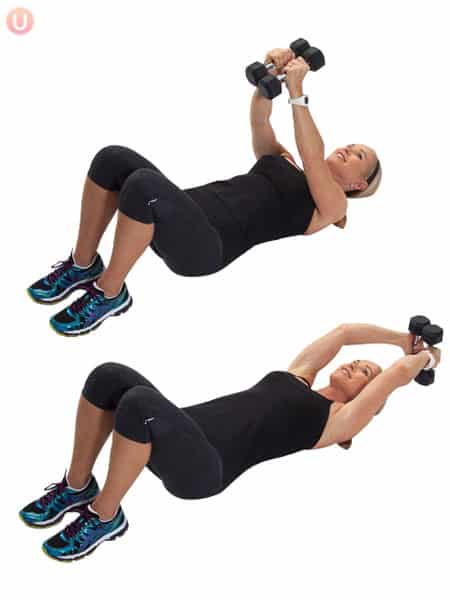
- You will need a set of medium-to-heavy dumbbells. AI would personally grab a set of 12 or 15 lb dumbbells, but anywhere between 8 lb and 20 lb dumbbells would be recommended depending on your level of fitness.
- Complete 12 repetitions per exercise and repeat the entire workout a total of 3 times!
1. Basic Squat
The basic squat is a fundamental lower-body exercise that targets your thighs, hips, and buttocks.
How to Perform a Basic Squat:
- Stand tall with your feet hip-distance apart. Your hips, knees, and toes should all be facing forward.
- Bend your knees and extend your buttocks backward as if you are going to sit back into a chair. Make sure that you keep your knees behind your toes and your weight in your heels.
- Rise back up and repeat.
2. Deadlift
The deadlift is a compound weightlifting exercise that engages muscles throughout your body, especially targeting your hamstrings, glutes, and lower back.
How to Perform a Deadlift:
- Start standing with feet hip-distance apart and then dumbbells resting in front of thighs.
- Tighten your abdominals and keep a flat back as you bend the knees slightly, lowering the dumbbells towards the floor.
- Squeeze the glutes and use your hamstrings and legs to lift and return to your upright position.
3. Alternating Lunges
The alternating lunge exercise targets lower body muscles while also improving balance and coordination.
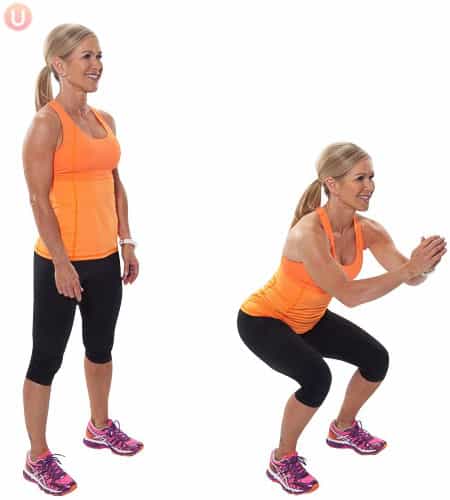
How to Perform Alternating Lunges:
- Stand tall with your feet hip-distance apart.
- Take a large step forward and lower your body toward the floor. Both legs should be bent at a 90-degree angle at the bottom of the lunge.
- Push off the front leg to rise back up to start, and repeat on the other side.
- Perform 6 reps on each side.
4. Single-Leg Hamstring Bridge (Left Side)
The single-leg hamstring bridge is used to engage your hamstrings and glutes which stabilize the body and improve lower body strength and stability!
How to Perform a Single-Leg Hamstring Bridge:
- Lie on back with bent knees hip-distance apart, and feet flat on the mat stacked under the knees. Extend one leg long towards the ceiling.
- Squeeze glutes and lift hips off the mat into a bridge. Lower and lift the hips for the desired number of reps then repeat on another side.
5. Pistol Squat
The pistol squat is a bodyweight exercise that challenges your balance, strength, and flexibility in your lower body.
How to Perform Pistol Squats:
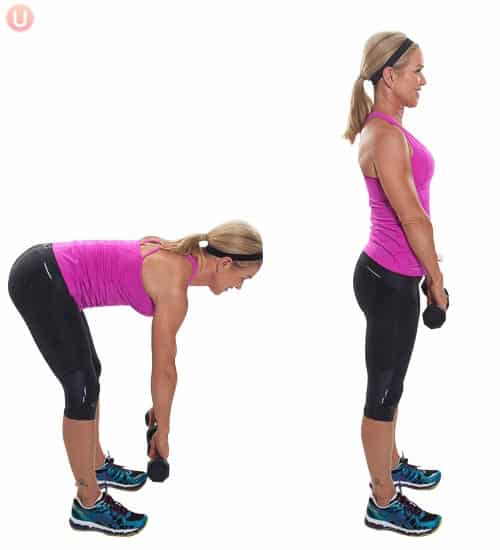
- Stand with feet hip-distance apart and extend 1 leg long on the front of the body.
- Bring hands to hips or the front of your body for balance. Sit back into a squat with weight in the heel of the foot, then slowly stand back up using your glute and hamstring muscles.
- Repeat for the desired number of reps and switch sides.
6. Single-Leg Hamstring Bridge (Right Side)
Complete the same single-leg hamstring bridge you did earlier, but on your right side!
Instructions Reminder:
- Lie on back with bent knees hip-distance apart, and feet flat on mat stacked under the knees. Extend one leg long towards the ceiling.
- Squeeze glutes and lift hips off the mat into a bridge. Lower and lift the hips for the desired number of reps then repeat on another side.
Muscle Groups Workout #3: Biceps, Triceps and Shoulders
I designed this HIIT upper body muscle group workout to target and strengthen your back, biceps, and shoulders in one efficient training program. All you need is dumbbells and your body weight!
Bicep, Tricep, and Shoulder Workout Instructions:
- Choose a light to heavy set of dumbbells (I use anywhere between 10-12 lbs) that you can hold onto for a 20-second internal.
- Perform each exercise at the highest level possible for a working interval of 20 seconds, followed by a rest of 10 seconds before moving to the next move.
- Repeat the entire training sequence for a total of 5 intervals (approximately a 20-minute workout)
Block 1: Bicep Curls, Push Up Punches, Hammer Curls
Perform each of these exercises for 20 seconds followed by 10 seconds of rest before moving to the next exercise:

- Bicep Curl
- Push Up Punch
- Hammer Curl
Block 2: Tricep Kickbacks, Tricep Dips, Overhead Tricep Extensions
Perform each of these exercises for 20 seconds followed by 10 seconds of rest before moving to the next exercise:

- Tricep Kickback
- Tricep Dips
- Overhead Tricep Extension
Block 3: Overhead Shoulder Presses, Shoulder Front Raises, Renegade Rows
Perform each of these exercises for 20 seconds followed by 10 seconds of rest before moving to the next exercise:

- Overhead Shoulder Press
- Shoulder Front Raise
- Renegade Rows
Muscle Groups Workout #4: Glute & Abdominal
The popular glutes and abdominals muscle group workout will strengthen your core and stabilize your hips while improving posture and overall athletic performance. The glutes and abs are two of the most popular muscle groups to workout together!
Glute and Abdominal Workout Instructions:
- Perform each of the circuit exercises below for 30 seconds, repeating the entire circuit 4 times total.
- After finishing Step 1, complete the "burnout" circuit performing each exercise for seconds, repeating the circuit two times.
Circuit 1: Glutes and Abs
Complete each of the exercises below for 30 seconds each, rotating through the complete circuit four times through:
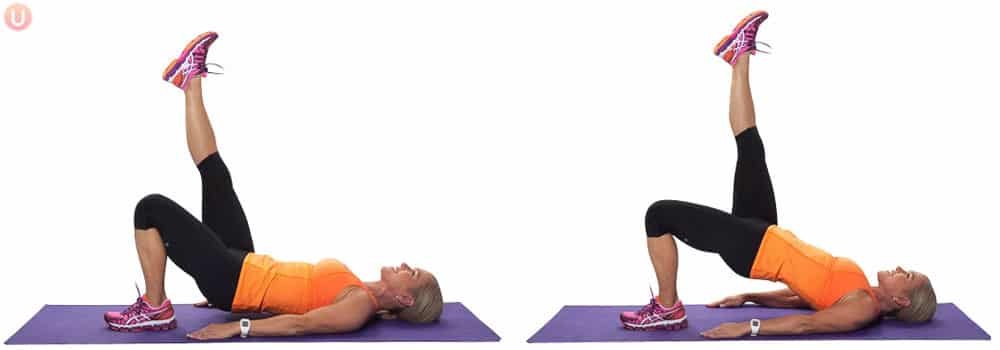
- Cross Behind Lunge (30 Seconds)
- Forearm Plank (30 Seconds)
- Glute Kicker (30 Seconds)
- Full Sit Up (30 Seconds)
Circuit 2: Burnout Exercises
End your workout by completing the two exercises below to "burnout" or for 30 seconds. Complete this circuit two times through:
- Burpees (30 Seconds)
- Superman (30 Second Hold)
FAQS
How do I know if I'm using enough weight to build muscle?
You should pick a weight where you feel muscle fatigue by the 15th repetition. It's the feeling like you can barely do one more rep. But if you are a beginner, then start lighter and build up to allow your joints and muscles to acclimate.
Should I use different weights for different muscle groups?
Many of these exercises in our workout are just bodyweight. But as you get stronger you can add dumbbells. And yes the larger muscle groups like lower body muscles, chest, and back can take heavier weights than your smaller muscle groups like shoulders, biceps, and triceps.
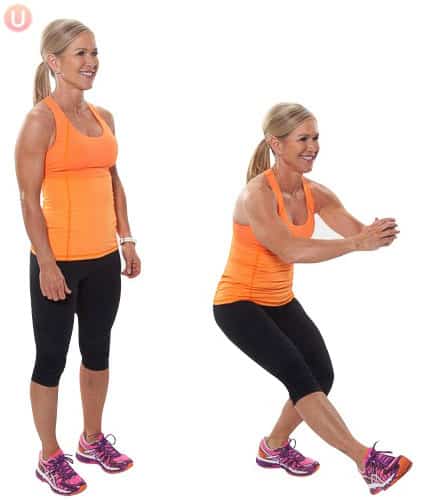
Which day of the week should I be doing strength training?
There is no right way to divide up your week. It all depends on your job, lifestyle, and fitness level. It's a good idea to allow at least one or two days between strength sessions to allow your muscles to recover and repair.
What is DOMS?
Delayed-onset muscle soreness (DOMS) is muscle pain and stiffness that occurs after strenuous or unusual physical activity. It's the phenomenon that happens as part of the repair process that happens in your muscles in response to microscopic muscle damage caused by strength training. Often DOMS is worse on Day 2.
*** Please support our sponsor *** |
 Image Credit: Alicia Mahoney / AuthorsUSA.com
Image Credit: Alicia Mahoney / AuthorsUSA.com |
 HealthWellnessFitnessBeautyVideosPrivacy PolicyTerms And Conditions
HealthWellnessFitnessBeautyVideosPrivacy PolicyTerms And Conditions
